Cary disease ecologist Barbara Han is working to predict zoonotic diseases to preempt future outbreaks. Her recent work is looking at animals that could host and transmit SARS-CoV-2, the virus that causes COVID-19.
Han says, “Zoonotic diseases emerge where people, animals, and pathogens overlap. Through activities like farming, live animal trading, wet markets, and ecotourism, we are increasing our contact with animals and the pathogens they carry. Globally, people are encroaching on wildlife habitat while climate change is forcing species into new places. These changes increase the likelihood that a pathogen will jump to new host species, with potential for mutation.”
‘Spillback’ is when a zoonotic disease spreads from people to animals. ‘Secondary spillover’ is when a spillback infection is passed back to people.
“Since the COVID-19 pandemic began, we have seen new strains emerge, each with unique symptoms and levels of transmissibility,” says Han. “Identifying animals with the potential to become infected and also transmit SARS-CoV-2 is critical to preventing spillback infections and dangerous new variants, which can develop when pathogens move between species.”
Han’s team is using information on biological traits of animals to predict high-risk species that should be targeted for SARS-CoV-2 testing and surveillance. Their methods combine machine learning, mapping, and molecular modeling approaches in novel ways. Identifying risky species can help wildlife managers and public health officials target areas and animals that should be prioritized for monitoring to prevent spillback and secondary spillover infections.
What makes an animal susceptible to COVID-19? Han explains, “Infection potential partially lies in the ACE2 receptor – a structure on the surface of a host cell that allows the SARS-CoV-2 virus to enter the cell, like a lock and key. Whether an infected host can spread the virus to people or other animals depends partly on the ‘binding strength’ – that is, how ‘tight’ the lock and key fit together. If a species has the ACE2 receptor, it could become infected; if binding strength is high, it is likely able to transmit.”
Han’s team created a model to predict mammals that could contract and spread SARS-CoV-2 based on their biology and information on the ACE2 receptor. A number of species flagged by the model as ‘high risk’ have since been confirmed for COVID-19 infection; these include white-tailed deer, red fox, snow leopards, and deer mice, among others.
Han says, “Our model found that the riskiest mammals include many that live in disturbed landscapes and in close proximity to people – including pets, livestock, and animals that are traded and hunted. This makes it easy for the virus to infect new species.
We have already seen diminishing vaccine efficacy with new variants. Each time the virus infects a new host, there is a chance that it will mutate and become more dangerous. Targeting high-risk species for lab validation and field surveillance is critical to identifying early interventions needed to prevent spillback infections.”
Han concludes, “We should also explore underutilized data sources like natural history collections, to fill data gaps about animal and pathogen traits. More efficient iteration between computational predictions, lab analysis, and animal surveillance will help us better understand what enables spillover, spillback, and secondary transmission – insight that is needed to guide zoonotic pandemic response now and in the future.”






